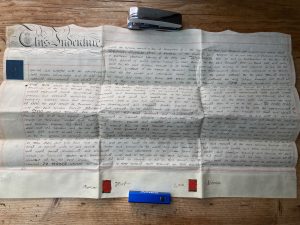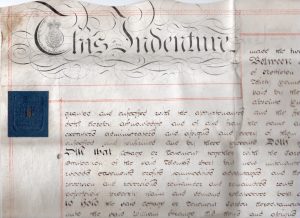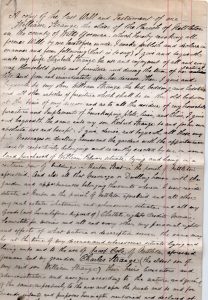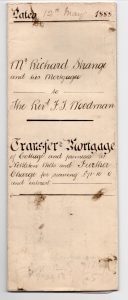Author: Chris Bennett
Pound Cottage, Burton (early/mid C18th) – (Part 2)
This article will form part 2 of a previous article relating to Pound Cottage, (part 1 can be found here )
As previously mentioned within part 1, the current owners of Pound Cottage (Simon & Kim) have very kindly allowed access to a number of documents which represent some historical transfers of title of the property through the ages. In this article we will focus on some documents appertaining to the ownership and occupants of the property in 1823 & 1888. I hope you find this very brief glimpse into the life of some families residing in Burton nearly 200 years ago, an interesting read.
What more do we know about Pound Cottage, Burton
The below document written on parchment is a photographic copy of an Indenture dated 22nd November 1823, due to its overall size (271/2” x 17”) I should apologise for the lack of readable detail; however, it gives a fantastic reminder on the style and appearance of legal documents which were in use at this time in history. As you are probably aware, more modern house owners get these days on the purchase of a property, is a computerised copy of the Land Registry Title Deed. Who knows where or what happened to original documents!
Importantly this document shows a blue wax seal to the left margin and red seals at the foot of the document. The blue seal relates to the ’stamp duty’ paid to the tax office, in this particular case, a sum of £1.15s.0p. Also, you can see the two red seals alongside the party signatures as witnessed.
Seals have been around for hundreds of years, but their purpose has changed a lot during that time. The term “under seal” for instance, has little in common with the main reason for using a physical seal in the past. But what actually is a seal? The use of a seal, which could be a blob of wax, a watermark, or some other kind of unique mark, is to help confirm the authenticity of a document. Seals were often used in conjunction with a signature to confer authenticity. Notary publics (a Notary is a type of lawyer who has the legal authority to see that documents are correctly signed or that they are true copies to make documents official or legal) who may still use a seal together with their signature to confirm the authenticity of a document or acknowledge witnessing a sworn statement.


Stamp Duty was first introduced in England in 1694 to help fund the war with France. It originally imposed tax duties on a range of legal documents, such as cheques, property and land transactions, receipts, etc. For these documents to be legally effective, a physical revenue stamp had to be attached or impressed on the document to show the stamp duty had been paid.
Stamp Duty was quite a success and led to substantial gains in the crown’s treasure, and the taxes were later extended to cover other items such as playing cards, newspapers and advertisements, hats, gloves and mittens, attorneys’ and solicitors’ licenses, perfumes, cosmetics, hair powder, receipts, and paper. This is not an exhaustive list, and with changes, it continues until today in the form of Stamp Acts.
This particular ‘Indenture’ document concerns the two parties Thomas Hart and William Strange.
Simon & Kim (the present occupiers of Pound Cottage) also provided an 8 page handwritten ‘last will and testament’ for William Strange Sen., dated the 25th May 1847 as witnessed by a Jacob Philips of Chippenham and Charles Laws (his clerk) A quick search of historical archives reveals a solicitors firm named Philips and Creswick operating during 1832 in Chippenham.
Page 1 is shown below.

The will is written in a legalistic form and clearly identifies the wish to revoke all previous wills and states (below are only small interesting extracts):
Quote:
“I give and bequeath unto my wife Elizabeth Strange the use and enjoyment of all and every household goods and furniture during the term of her natural life. From and immediately after her decease, then I give and bequeath to my son William Strange the bed, bedding and all other articles of furniture which shall be in the old bedroom at the time of my decease and as to all the residue of my household furniture and implements of housekeeping, plate, linen and china, I give to and bequeath the same unto my son Richard Strange to and for his own absolute use and benefit. I give, desire and bequeath all those my five ?? or dwelling houses and the gardens with the appurtenances there to respectively belonging and recently erected by me on some land purchased of William Palmer situate lying and being in a certain row of buildings in Burton Street in the Parish of Nettleton aforesaid”
The will then directs many additional tasks for the investment of residuary personal estate by auction of private contract and to get the most money and best price. It also goes on to direct the trustees/executors of the will to pay his wife Elizabeth an annuity or clear annual sum of £20 sterling clear of all outgoings whatsoever. Additionally, the trustees/executors are directed to pay annual sums to all his three children Hannah, Richard and William.
At the foot of the will a Codicil, also written on the same date which directs the trustees/executors to ensure his grandson Charles has sufficient clothing until attaining the age of twenty-one. Also, to pay his grandson Charles once he has reached the age of twenty-one the sum of £10 for the purpose of purchasing working tools.
Moving on in time we can take a look at another Transfer of Mortgage (dated 12th May 1888) for £71 10s 0p (shown below) between John Nowell a Tallow Chandler of Castle Combe, Richard Strange a gardener of Nettleton and the Rev Frederick T Woodman a Clerk in Holy Orders and Rector of Nettleton between 1870-1891 (and died 19.11.1891 at Nettleton)
The document would appear to be the sale of the property and an agreement for the Strange family to remain in the cottage, provided the property in insured against loss or damage by fire in the sum of £100 at least, and will produce a copy of the policy and the receipts for every premiums paid to Rev. Woodman.
You may ask – What is a Tallow Chandler?
A Tallow Chandler is specifically a person who makes and sells candles. Historically candles were mostly made from tallow, a form of animal fat that provided an inexpensive way for people to light their homes at night.
(Page 1) only shown below, again shows the ‘Stamp Duty’ paid in the sum of 1s 2p.


Census records (1851 & 1861) for Nettleton Parish (as shown in Part 1) revealed William lived with his wife Elizabeth, 3 sons and a daughter. He was shown to have an occupation as a butcher of pigs. One of his sons Richard can be seen to be living at Pound Cottage in the 1911 census and is identified within the title deeds of the house dated 1888
It would appear the Strange family were certainly occupants of Pound Cottage from 1823 until at least 1911.
More research could have been done on this topic but as always, I must TRY and keep things concise, so what next you may ask?
The Bugle Editorial Team would like to thank current residents (Simon & Kim) for providing some of the fascinating story behind one of our historic village buildings.
Reference Material:
With grateful thanks to The Wiltshire and Swindon History Centre in Chippenham



0 Comments